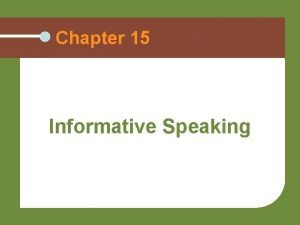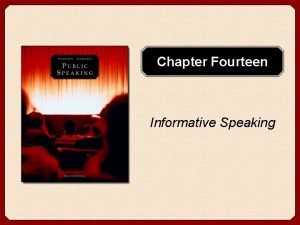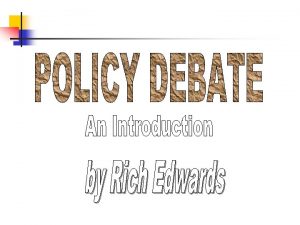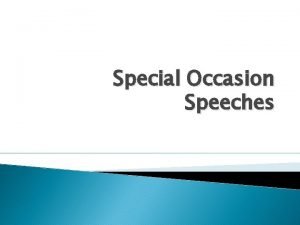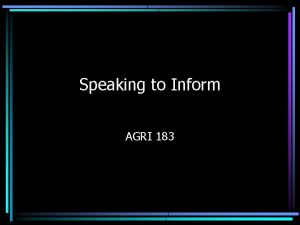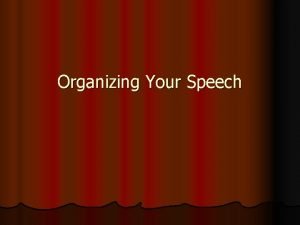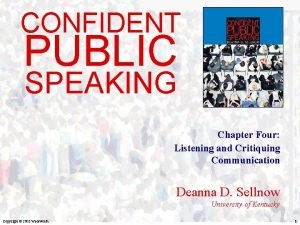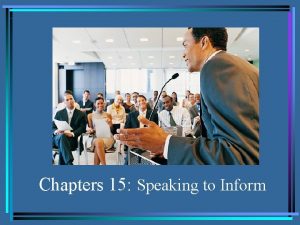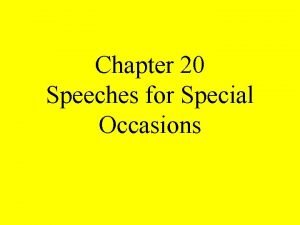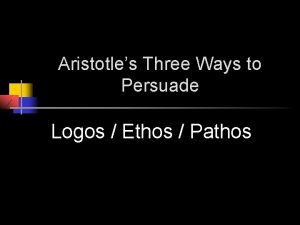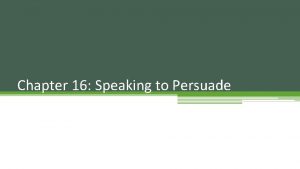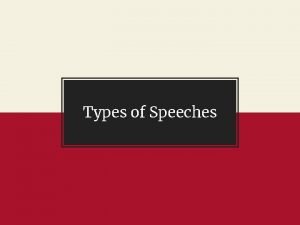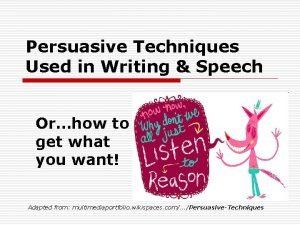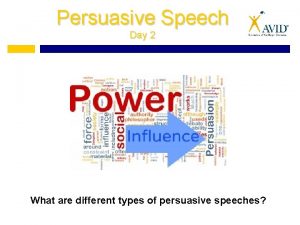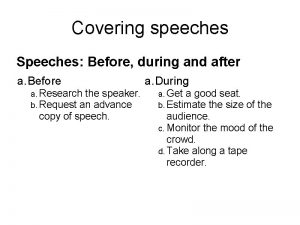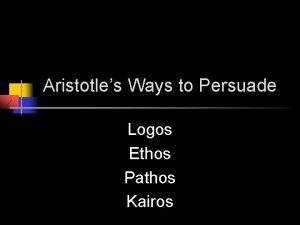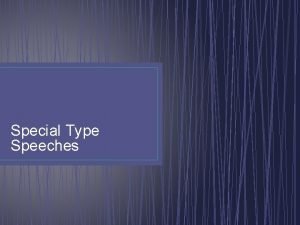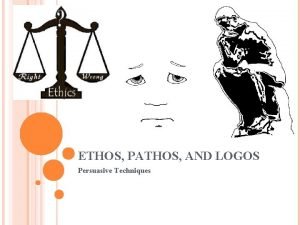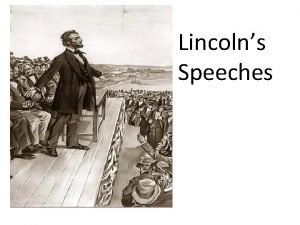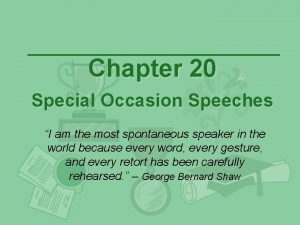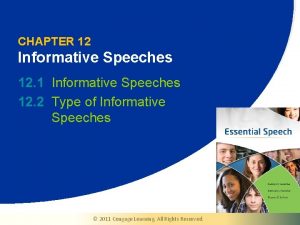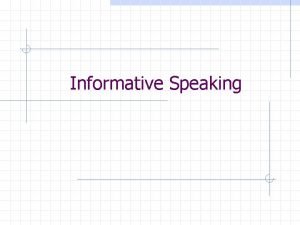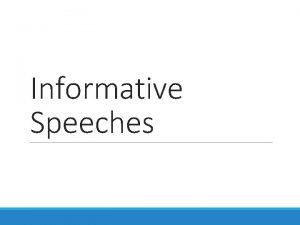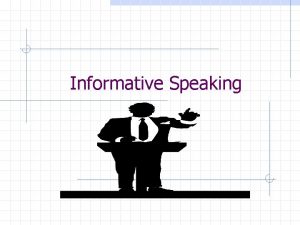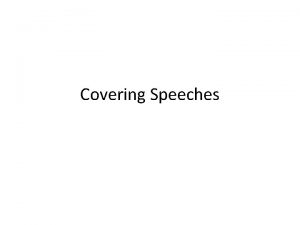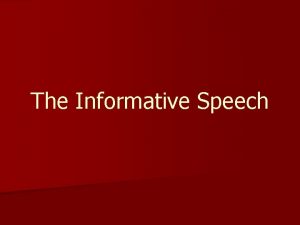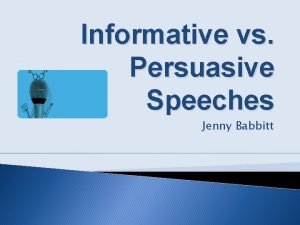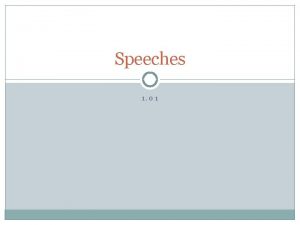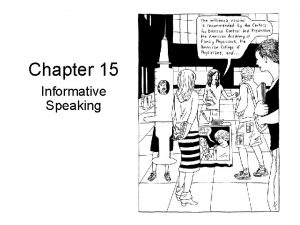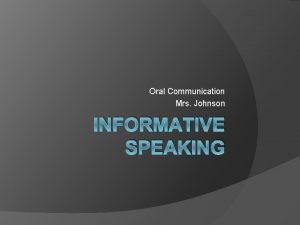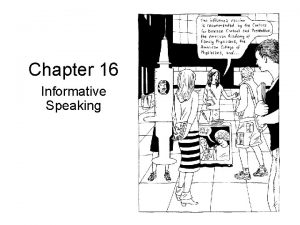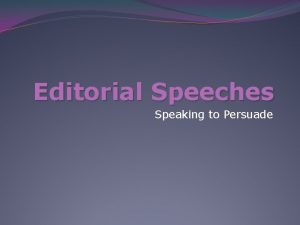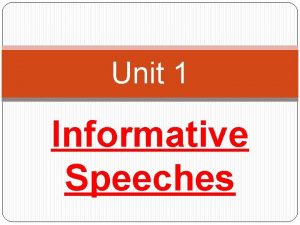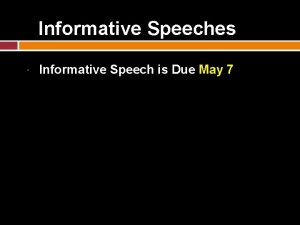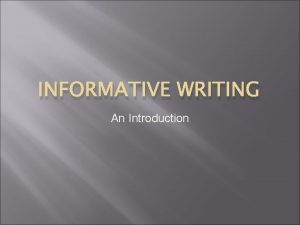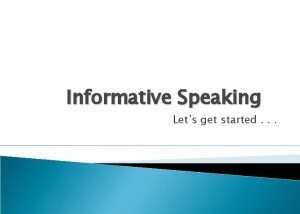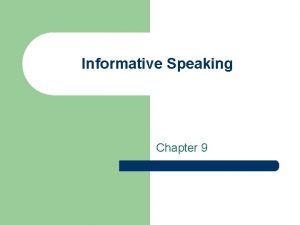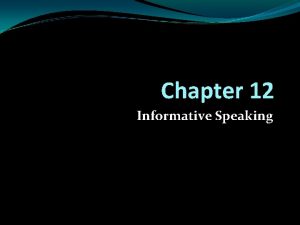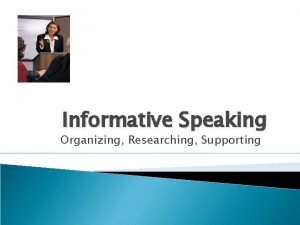Informative Speaking Section 2 Informative speeches are descriptive





































- Slides: 37

Informative Speaking: Section 2

Informative speeches are descriptive Describing an object, event, topic, person, place Audience must be able to gain understanding and place it in context Information for informative speeches can lay the foundation for persuasive speeches

Topic Selection Consider audience makeup and context. Three Concerns when choosing a topic What do you want the audience to LEARN?

Topic Selection: Considerations Appropriateness – How fitting is your topic for your audience? Is your topic appealing to the entire audience? Will the audience see your topic as controversial? Significance- How important is your topic to the audience? Your audience should learn something from your speech Trivial topic is an insult to your audience’s intelligence Add interesting options, tips, advice Scope – How much breadth or depth should you cover Better to cover a small topic with more depth than a large topic lightly

Scenario I want to inform my audience about U. S. History. What would you tell me and ask me about the topic? Would you encourage me to keep or change this topic? How would you help me pick a new topic if you decide U. S. History is not a good choice?

Scenario I want to inform my audience about outer space. What would you tell me and ask me about the topic? Would you encourage me to keep or change my topic? How would you help me pick a new topic if you decide outer space is not a good choice?

Research… Should Be: Accurate Is the information correct? Pertinent Does citation relate to matter at hand? Timely Is the information current?

QUESTION YOUR SOURCES!! Who produced this information? Can you tell where this information originally came from? Are you getting this information from the original source?

QUESTION YOUR SOURCES!! Is this information relevant? Does the information being provided meet my needs? Is this information appropriate for my audience? Is this information provided at a level and in a language my audience will understand? Is this information factual and objective?

QUESTION YOUR SOURCES!! Is this information reliable? Is this the best source for this type of information? How do I know if the producer of this information is qualified to provide this information? Does the producer have the appropriate background or experience? If you compare the information with another source, do they agree? If not, can you determine which is the more reliable source? Has anyone else reviewed this information Is the information verifiable?

Importance of citing sources Sharing your sources with your audience allows them to decide if they will accept your information as authoritative. Selecting quality information as sources is part of the process Ethical issues – if you are using other peoples information you need to cite them.

How to cite sources MLA format Verbal Citations Important because they create speaker credibility, establish reliability of the information and avoid plagiarism. EXAMPLES: “According to Dr. Jones from the Riley Hospital for Children. ” “An article titled ‘Modern Theology’ in the January 2012 issue the journal Religion notes that. . ”

How to cite Sources Written In-Text Citations Indicate who (or what) has provided the information Dr. Seuss stated “you’re too smart to go down any not-sogood street” (4). Once you have left home and are off on your own, remember to always use common sense, because “you’re too smart to go down any not-so-good street” (Dr. Seuss 4). Dr. Seuss encourages us to use good judgment and choose the best paths when deciding where we want to go in life (4).

Works Cited Sources should be listed in Alphabetical Order! For a Book: Lastname, Firstname. Title of Book. City of Publication: Publisher, Year of Publication Medium. Dr. Seuss. Oh, the Places You’ll Go!. New York: Random House Children’s Books, 1990. Print. For an Article: Author. “Title of Article. ” Title of Journal Volume, Issue (Year): pages. Medium of Publication. For a Website: Editor or author (if available). Name of Site. Version number. Name of organization offering the site, date of the resource creation (if available). Publication medium. Access

Ethics 2. 4 Ethos- Credibility/Trust Personal branding Confidence in delivery Cites credible sources Logos- Logic/Reason/Proof Structure of the speech- opening, body, conclusion References to studies, case statistics Comparisons, analogies, and metaphors Pathos- Emotions/Values Stories Inspirational Quotes Vivid language

Audience 2. 5 Audience Centered Multiple Audiences Audience Adaptation Establish common ground with audience to relate topic Inclusive language is required Remove ethnocentric language and demographic stereotyping People create meaning together through communicative interaction View your audience as collaborators

Why is Organization Important? Makes information Manageable for the audience. How can I best create meaning for my audience? Organizational Pattern Chronological – Used when the main points you plan to make in your speech are naturally related to each other by time. Spatial – Used when your topic is structured according to geography or location. Topical/Categorical – Most often used for informative speeches. Many topics you investigate are naturally grouped around headings, categories, or clusters of information. You can use the natural, logical clusters of info to arrange your speech. Ex) You may choose to organize your speech topically from least to most important, from simples to most complex, or least to most familiar.

How does Listening Affect Organization? People learn better when they hear important ideas a few times or in a few different ways This is why we preview main points in the intro, expand on them throughout the body, and review main points in the conclusion. Tell the audience what you are going to tell them. Tell it to them. Tell them what you told them. People learn better when new knowledge or information is delivered in small, manageable, organized “bites”

Organizing your speech All speeches are structured in three sections Introduction (beginning) Body (middle) Conclusion (ending)

Introduction Attention-seeking device Tie-in to the audience (TIA) Credibility statement Thesis (including a preview of points)

Attention Seeking Devices Humor Stories Quotations Imagery Shocking Statistics Rhetorical Questions

Tie-in to the audience Connects your topic to your audience Answers the question, “What’s in it for me? ” from your audience Failure to connect the topic to the audience = reduced credibility and attention to your speech

Credibility Statement Answers the question, “Why are you qualified to talk about this subject” from your audience Make it conversational Avoid beginning with “I’m credible to talk about this because…”

Thesis Provides a roadmap for your audience Answers the question “What’s this speech going to be about? ” from your audience Audiences like to know what direction you are headed; it keeps them engaged

The Body Outlining the body of the speech requires that you follow the 5 principles of outlining: 1. The body should be constructed to include between 2 -4 main points. 2. Your ideas should be organized into main points and their subordinate points without overlap. 3. Each main point should have at least two subordinate points. 4. Main points and subordinate points should be organized logically. 5. Main points and subordinate points should have parallel structure

Organization: 3 Primary Paths Chronological Time Sequence In March I appeared on “Jeopardy. ” Spatial Geographical/ Location Then, in April I appeared on “The price is Right. ” Finally, in May I made a guest appearance on Family Feud. You can start your Appalachian Trail adventures in Fannin County, GA About 2 miles from the midpoint, you might consider visiting Pennsylvania’s Pine Grove Furnace State Park Finally, achieve bona fide wilderness explorer status when you reach Mt. Katahdin in Maine. Topical Categorical First, I will inform you how to properly dress for an interview. Next, we will discuss proper attire for an evening work event. Finally, I’ll help you judge how to create an appropriate “Casual Friday” outfit

Language Define new terms Give audience a frame of reference Create shared perspectives Intentional language choice gives the speaker power to identify with his/her audience.


Conclusion Endings do 3 things: Reinforce your thesis Review your points Remember – leave your audience remembering your speech

Tips on intros and conclusions Memorize and polish them! They’re the audience’s first and last impression of you Use similar techniques for endings as you did for beginnings

Delivery 3 General speaking methods: From Memory From Manuscript Extemporaneously Rehearsed Minimal notecard reference

Vocal Delivery: Vocal Variety How can vocal variety influence audience engagement? ACTIVITY TIME! We will focus on Rate Volume Articulation Pronunciation Emphasis

Visual Aids ENHANCE points & Create Impact Present information (or data) in another way. Be cognizant of when visual aid is on or off, or when it starts and stops.

Solar System: The Planets

8 Planets 1. Mercury 2. Venus 3. Earth 4. Mars 5. Jupiter 6. Saturn 7. Uranus 8. Neptune 9. Pluto?

Solar System: The Planets 8 Planets 1. Mercury 2. Venus 3. Earth 4. Mars 5. Jupiter 6. Saturn 7. Uranus 8. Neptune 9. Pluto?

Solar System: The Planets
 Antigentest åre
Antigentest åre Uil extemp topics
Uil extemp topics Characteristics of effective informative speaking
Characteristics of effective informative speaking The goal of informative speaking is
The goal of informative speaking is What is the essence of informative speaking?
What is the essence of informative speaking? Instructive text types
Instructive text types One face one voice one habit and two persons
One face one voice one habit and two persons Constructive speech
Constructive speech What are special occasion speeches
What are special occasion speeches Speeches about objects
Speeches about objects Logos ethos pathos
Logos ethos pathos Strategic order of main points
Strategic order of main points My former speeches have but hit your thoughts
My former speeches have but hit your thoughts Sier model of active listening
Sier model of active listening Informative vs persuasive
Informative vs persuasive Speeches of courtesy
Speeches of courtesy What is direct address in persuasive writing
What is direct address in persuasive writing Juxtaposition vs dichotomy
Juxtaposition vs dichotomy Demonstrative speech ideas
Demonstrative speech ideas Ethos examples in speeches
Ethos examples in speeches American rhetoric 100 speeches
American rhetoric 100 speeches Speeches on questions of value are usually organized
Speeches on questions of value are usually organized What is demonstrative speech
What is demonstrative speech Persuasive techniques used in speeches
Persuasive techniques used in speeches List the types of persuasive speeches.
List the types of persuasive speeches. What is a expository speech
What is a expository speech Obituaries speeches
Obituaries speeches Ethos examples in speeches
Ethos examples in speeches Entertaining speech
Entertaining speech The outsiders literary analysis essay
The outsiders literary analysis essay Example of closing remarks for webinar
Example of closing remarks for webinar Logos examples
Logos examples Lincolns speeches
Lincolns speeches Special occasion speeches
Special occasion speeches Hidden lines are not generally omitted in a sectional view
Hidden lines are not generally omitted in a sectional view What is a revolved section
What is a revolved section Difference between half section and full section
Difference between half section and full section Section 2 describing energy
Section 2 describing energy



